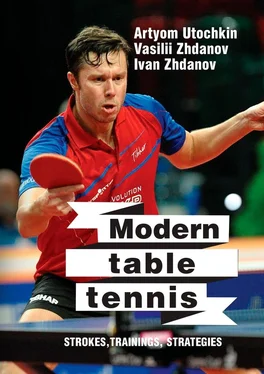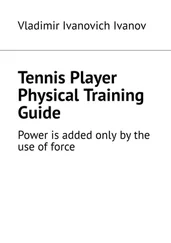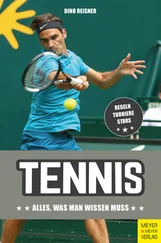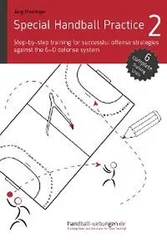Summation after responsible and important games.Regardless of the achievements of the national team, Chinese experts collect all materials into a large report for analysis and summation.
Having examined the basic organizational scheme of the Chinese national team let’s move to the main principles used in the preparation of Chinese athletes.
Recapturing initiative in the game
The fundamental premise of athlete’s tactical action sounds like this: “creating moments to recapture the initiative”. What does this mean? When making strikes one should impose a defensive style of game to his opponent, performing hard strokes to inconvenient spots. The initiative should be seized at each stage of the game process, starting from service and ending with the block. While in defense, you should look for an opportunity to weaken the opponent’s pressure and make counterdrives, “taking game control by the throat”.
Developing the strengths
Coach must identify the strengths of the athlete and build the training on the basis of his strengths development and its variation. When strengths become second nature, it allows one to be all over the game. That’s how a unique style of player emerges.
Mastering weaknesses
Constant mastering of the athlete weaknesses during the training process. The modern player should have versatility and ability to play in different situations. Obvious weaknesses are identified by the opponent, who puts his efforts into focusing on them.
Constant competition
Learning the necessity to constantly seek the opportunity to attack and possess the initiative in the rally. Attacking, aggressive style of play and the constant competition – is one of the critical success factors in today’s tennis.
The balance between defense and attack
The player should be mature both in attacking and defensive style – this will create additional space for maneuverability and variety during the game. The opponent must never predict how one returns the ball.
The aggressiveness, speed, spin and unpredictability
The aggressiveness throughout the game and a desire to take the game control over. The ever-increasing speed along with the spin. Only their combination will lead to success. The unpredictability of the game in order to not let the opponent unlock your game strategy, so he would always be under pressure and constrained in his actions.
Chapter 2. Basic strokes of modern table tennis
Let’s start with the most important stroke in table tennis – topspin/loop. Top-spin ( top-spin ) is translated from the English language as the top rotation (spin). In fact, any ball that has a top-spin in table tennis logically should fall within the definition, but it is actually more complicated.
When we say “top-spin”, we mean a powerful attacking element, which provides maximum top rotationand the speed of the ball.
Top-spin is a table tennis game element that is the most acute and difficult to return.
All players with senior adult degree and higher are capable of forehand top-spin, but in the hands of the masters among first one hundred strongest athletes in the world it is a powerful weapon, which they seek to apply in every rally (of course, in except the players, advocating a protective style) and win a point due to this element.
We’re going to devote this chapter to the forehand topspin – the most powerful and commonly used element in modern table tennis.
Different variations of the forehand top-spin
Forehand top-spin, as already mentioned, is an integral part of the technical arsenal in modern table tennis. Athletes playing in an attacking style (more than 90%) who perform 60—70% of attacks use exactly forehand top-spin. The number of points won due to forehand top-spin, in total, exceed 50% in the most matches.
The number of variations of the forehand topspin is outplayed, perhaps, only by the number of table tennis serve variations. However, if we consider only gaming elements,
the forehand top-spin is the most hygienic stroke.
To show you the importance of the forehand top-spin as an element, let’s imagine the following situation: imagine that an athlete can’t perform forehand top-spin at all, but he masters all other tennis elements. What are the chances of such athlete? Perhaps his chances, in this case, tend to zero.
Now, for example, let’s “take away” the backhand top-spin from our imagined character. Will there be any chance to succeed for such an athlete? Definitely! Do not believe? Remember who became the Olympic champion in 2004. Right, Rue Seun Min. The representative of classical penhold with the ability to perform only a forehand top-spin.
The point is, that even without having a backhand top-spin in the arsenal, one can become an Olympic champion.
The same is with any other game element (serve is not a gaming element). The absence of any element can be compensated. But the absence of the forehand topspin cannot be compensated. All this stresses the crucial importance of this stroke in today’s table tennis.
Now let’s talk about the variability of the forehand topspin. Stroke technique is unusual due to the fact it has a lot of variations. And this is the last choice. Depending on a height, speed, rotation of a received ball, the top-spin technique is being changed. And that’s when the forehand top-spin technique changes are most significant than in other elements. Often, even different principles are used, but more on this later. For now, it’s enough to remember that forehand top-spin has many variations that differ significantly from each other in the T. Committee manner.
Let’s open a small secret. Most table tennis players make a lot of mistakes when performing forehand topspin on the right because they do not understand that each variation of the forehand topspin requires a separate insight and technical workover.
Conditionally, we can distinguish 10 variations of the forehand topspin shot; whereas, it can be divided into some subvariations. It is worth noting that it’s not widespread. So, let’s now briefly consider the following: What stroke variations exist and in what situations are they used?
Variation #1. Forehand top-spin against a simple ball or block
This is a classic top-spin, the basic version of which is being mastered at the earliest stages of learning table tennis techniques. We can say that everything starts with this variation. Not mastering it sufficiently, you will not be able to master the other. Not even worth trying. It’s like learning to run if you didn’t learn how to walk. Everything is good in its season
Forehand top-spin is performed against the block during the open rally in table tennis when one athlete attacks and the other is forced to defend himself, returning the ball to the table with a block or, as it is also said in table tennis, “drive”.
There’s another branch of this variation: Forehand topspin against the block, that is performed in return to the chop.
Let us explain. Imagine that during a match you performed a serve with a lower spin and received a chop with a top-spin. Your opponent received the ball, and you’re doing a second top-spin. But what’s the difference, because a top-spin against the block is a top-spin against the block? But there is a difference.
The fact of the matter is that when you make a top-spin with a chop, your opponent receives it with a block, a spin from your top-spin remains. And this rotation requires a slightly different handling than with a drive against the block.
Читать дальше












